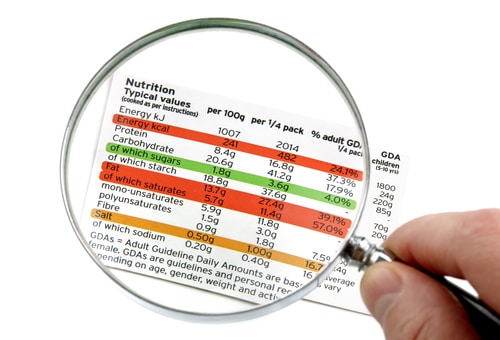
Trans-fat Free Doesn’t Always Mean Trans-Fat Free
When you read a nutrition label and see zero grams of trans-fat, you probably assume you’re eating a product that contains no trans-fat. Not necessarily so. The FDA has given manufacturers a loophole. If a serving contains 0.5 grams of trans-fat or less, a company can list 0 grams of trans-fat on the nutrition label. 0.5 grams doesn’t sound like a lot, but if you eat more than one serving, it adds up. Research shows that even small amounts of trans-fat increase the risk of heart disease. To determine whether a product is truly trans-fat free, scrutinize the ingredient list. If it lists partially hydrogenated oils or fractionated oils in the ingredient list, it’s not.
Serving Size Trickery
You pick up a protein bar and see it has 150 calories. That doesn’t sound unreasonable so you toss it in your cart. Be careful. If you don’t check the number of servings in the bar, you could end up eating double. Most people assume that a single protein bar is only one serving, but some bars are actually two servings. It looks “healthier” to have a lower calorie count on the package, and manufacturers are hoping you won’t check the serving size. After looking at the calorie content, look just above the calorie count to see how many servings are in the package. Check the grams of sugar too. If there are two servings, that’s double too.
Sugars in Disguise
Food manufacturers don’t like to play up the fact that sugar ranks high on their ingredient list. So they disguise sugar under more respectable names like evaporated cane juice, malt syrup or any of a number of other names that are really just sugar in disguise. If an ingredient ends in -ose or -ase, you can assume it’s a sugar There are almost 50 other names that manufacturers can use that really spell sugar. Be familiar with these names, and always check the total grams of sugar. Four grams of sugar is equivalent to a teaspoon of the sweet stuff. The American Heart Association recommends that women get no more than 6 teaspoons of sugar a day and men no more than 9.
Contains Whole Grains
“Contains whole grains” appears on some bread labels, but don’t assume you’re getting a 100% whole grain product when you see it. Food manufacturers hope that you see the word whole grain and assume it’s healthy. There may only be a small portion of whole grains in the product and a larger portion of refined flour. The ingredient list tells the full story. If the first ingredient listed begins with “whole,” the product is mostly whole grain. Don’t be fooled by stoneground or multi-grain. They don’t tell you whether the product is whole grain or not.
The Bottom Line?
Don’t be fooled by nutrition labels. Take the time to read all parts of the label including the list of ingredients. Be a nutrition sleuth – and you’ll enjoy better health and a smaller waistline.
References:
University of Iowa Hospitals and Clinics “How to Read a Food Label”
Mayo Clinic “Added Sugar: Don’t Get Sabotaged By Sweeteners”
Whole Grain Council “Identifying Whole Grain Products”
Related Articles By Cathe:
Nutrition Confusion: How Many People Really Read Nutrition Labels?
Nutrition Guidelines: Why is There So Much Conflicting Information?
5 Food Label Deceptions to Watch Out For
5 Ways Nutrition Labels Have Changed
Food Labeling: What Do Those Supermarket Labels Really Mean?

